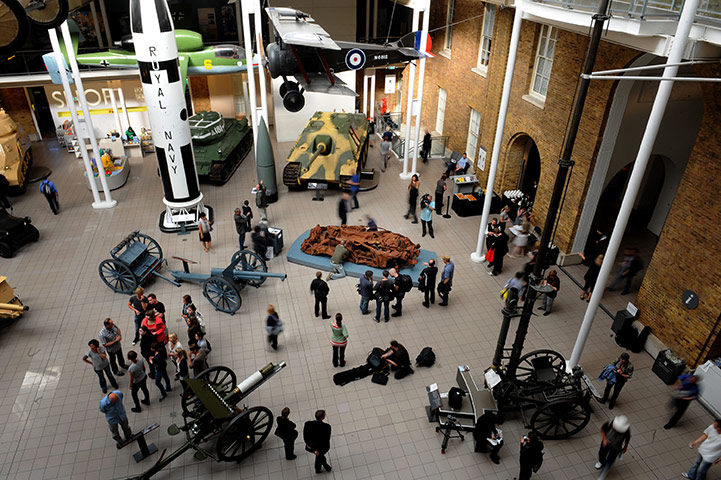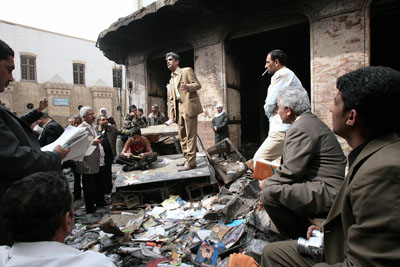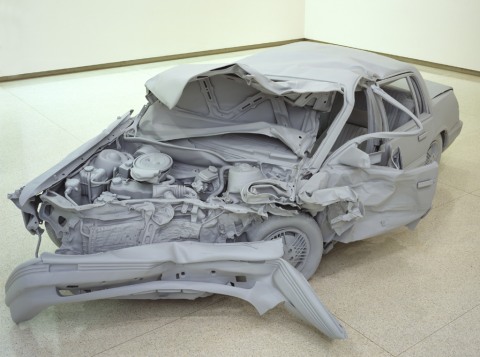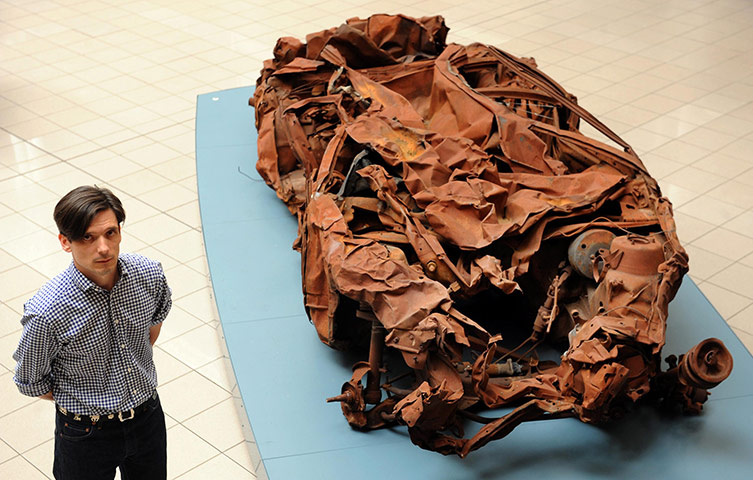
Jeremy Deller's "5 March 2007" on display in the Imperial War Museum, London. Photograph: Anthony Devlin/PA
There’s a new display at the Imperial War Museum, London, orchestrated by the artist Jeremy Deller, which consists of a burnt-out, red-brown car, mangled in an an explosion in Baghdad in 2007. Note that cagey indefiniteness, the tiptoeing choice of words. Deller’s project is as much an examination of the real cost of war, surrounded as it is by displays of warplanes and warheads, as it is of the language we use to describe it. It’s not an “installation,” it hasn’t been “curated,” and it’s not (according to the artist himself), even an “artwork.” It’s not, in other words, “by” someone, and what it’s about is, in part, the idea of authorship, and the meaning of authorship in a context of modern warfare. Deller’s disavowal of the word “art” to describe the car – which does have a title (5 March 2007), and was displayed in Deller’s show It Is What It Is at the New Museum, New York, last year, so has all the hallmarks of being a work of art – has parallels with the perhaps apocryphal story of the Gestapo officer stalking through Picasso’s studio, chancing across a postcard of Guernica, and asking the artist “Did you do that?” “No,” replies the artist, “you did.”
The car is recognizably itself, though bucked downwards as though crushed by an invisible weight, scorched and rusted beyond individual recognition. Time has stripped it of a personality it must have had, its stickers and detritus suggesting that it’s a “car” now, not “the car” and it has slipped, in this way, into a symbolic afterlife. The wreckage was salvaged after a bomb blast in Baghdad’s principal intellectual and cultural nucleus, the Al-Mutanabbi book market in the city’s old quarter. A witness, Naeem al-Daraji, describes the scene on the museum’s website: “Papers from the book market were floating through the air like leaflets dropped from a plane… Pieces of flesh and the remains of books were scattered everywhere.” The exact number of victims cannot be definitively quantified, but it is believed that around 38 people were killed.

Poet Abdul Zahra Zaki recites a poem outside the shell of the Al-Shahbandar café as part of a protest by artists and writers against the bombing of Al-Mutanabbi Street, March 8, 2007 © Ali Al-Saadi, AFP/Getty Images
The car is, then, both a relic of and a memorial to a specific historical event and its victims, but it’s also a marker of the extent to which war is now waged against civilian targets. Vehicles traditionally designed for war, which surround the display of the car in the museum’s atrium, startle in their frank utilitarian bullishness, their snouts and rivets and clanging carapaces. What startles in the car wreckage, though, is its combination of the alien (its crumpled and creased form, like a stepped-on beetle) and the intimate (the door, curled part-open in the blast, as though admitting a passenger, a child on a school run). Cars, unlike tanks or warplanes, have a one-to-one relationship with the human body; they’re for it, where tanks are against it. And there is, indisputably, painfully, a parallel with the broken human form itself. Springs and axles, bent to breaking point, become bone and entrails, bust open and scattered loose. It becomes a thing turned against itself, one of the metonyms of western civilized society (standing for family, for independence, for a kind of codified freedom, a word that, too, has turned against itself in the heat of recent events) performing its opposite.

Charles Ray, "Unpainted Sculpture," 1997
That the car has a past life in the New Museum exhibition – where the aesthetic of no aesthetic would accept the car unthinkingly as art within Duchamp’s long shadow – complicates matters, maybe. Its kinship with Charles Ray’s Unpainted Sculpture, his 1997 crashed car in grey fiberglass, and echo of John Chamberlain’s bent reliefs of car bonnets, muddies a strictly didactic, strictly historical reading. The car may not be “by” Deller in the sense that Guernica is not “by” Picasso, but, as with Picasso, both works describe themselves within the language of their time. Look at the car within the 2009 New Museum installation and that complication is clear.
By positing the car, however unwittingly, as contemporary art – or, rather, by proposing the touring and installation of the object as an artistic practice – Deller weaves the institution and viewer into the unfolding narrative of the object. It’s not over, in other words: the car’s persistence as an object pulls the viewer into its orbit, implying western culpability in the larger narrative of which the car is, really, a tiny fragment. We get to look, and the leisure and complexity of our looking – our ability to step back, pull apart, to see something as art – forms the backdrop. It echoes, endlessly, the explosion.

Jeremy Deller with "5 March 2007." Photograph: Anthony Devlin/PA




Pingback: Provisions Library » Blog Archive » The Iraq War is so last year